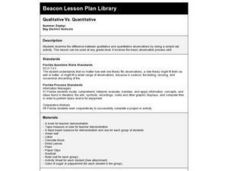Curated OER
Hydrocarbons
Making models is always memorable. In this activity, physical science starters examine the structure of hydrocarbons using marshmallows, raisins, and toothpicks. They even act as atoms themselves and link arms to represent covalent...
CK-12 Foundation
Sample Spaces and Events: Triple Spin!
Scholars determine the number of possible outcomes when a spinner is spun three times. They start with the case of one spin and build up to the case of three spins.
Curated OER
SIMPLE FABRIC FOLDING FOR HALLOWEEN
Study the fabric folding techniques introduced and lead your class in applying them to quiltmaking, home decorating, fashion design, and other sewing projects. This lesson is geared to making items themed for halloween, but could be...
EngageNY
Polynomial, Rational, and Radical Relationships
This assessment pair goes way beyond simple graphing, factoring and solving polynomial equations, really forcing learners to investigate the math ideas behind the calculations. Short and to-the-point questions build on one another,...
Illustrative Mathematics
Converse of the Pythagorean Theorem
Use the given tasks and detailed teacher's commentary to introduce your 8th graders to the Pythagorean theorem and its converse. Embedded links to information about Egyptian geometry make your presentation interesting. Consider...
Concord Consortium
Breaking a Molecular Bond
Breaking up is hard, especially with a third part involved! Watch as molecules of hydrogen, oxygen, and nitrogen try to keep it together as a neutral third atom bombards them. Users control the reactive molecules and the velocity of the...
PBS
Working with Common Denominators: Activities and Supplemental Materials
Enjoy these straightforward and simple activity pages that practice with different denominators. The practice starts simple with adding fractions together and then works on a recipe that needs to be tripled.
Curated OER
To Float or Not to Float - A Lesson on Density
Learners observe and experiment with the concept of density. This is done using a simple experiment that helps them to apply scientific principles of observation and proving a hypothesis.
Curated OER
Triple Meter
Students chant "Mabel, Mabel, Set the Table" in beats grouped in 4's using a percussive pattern. They repeat using 3's. Students sing a song in 4's and in 3's. they move to recorded music to practice threes. Students create Orff...
Curated OER
Simple Organic Compounds
In this organic compounds worksheet, students review 8 terms associated with hydrocarbon molecules. Students find these 8 terms in a word search.
PricewaterhouseCoopers
Conservation: Water
Here is a fantastic experiment-based instructional activity on water conservation, waste, and filtration. The lesson plan is well-developed and provides background information, discussion leads, and six scripted lab activities anyone can...
CPM
Direct, Joint, and Inverse Variation
Here is a quick guide to direct, joint, and inverse variation used in realistic situations. Each topic has a page of notes and examples followed by practice problems. The resource explains each type of variation and provides their...
Curated OER
Weathering Lab
Assist your middle school class with one of the most inclusive weathering and erosion labs available. Individuals use sugar cubes and alka-seltzer to demonstrate the process of physical and chemical weathering. They sketch results...
Curated OER
Simple Time
In this music instructional activity, students read a chart about time. For example, students read about the number of the crotchet beats, the minimum beats, and the quaver beats.
Curated OER
Molecular Modeling Activity
Students explore the concept of molecular modeling and differentiate between saturated and unsaturated compounds. In small groups, they identify molecular formulas, complete a chart comparing alkanes, alkenes, and alkynes, and construct...
Curated OER
Babylonian Mathematics 2
Students research Babylonian mathematics. They calculate simple surd numbers. Students find the fractional form of rational numbers expressed as decimals. They work with numbers in base 60.
Curated OER
Baseball Math
First graders solve baseball-themed addition problems. Working in pairs, 1st graders drill each other on simple addition facts using baseballs. At the completion of group time, students introduce their partner and share their...
Curated OER
Investigating Triangles 1
Young scholars independently investigate the Pythagorean Theorem. They are given a set of triangles that involve whole number Pythagorean Triples. The main focus of the activity is exploration rather than discovering the Pythagorean...
Curated OER
The Elastic Racquet
Students use this introductory lab using a tennis racquet, however it is very difficult to study because of the strings and the racquet stretch so little and so quickly during a match that students were unable to make simple...
Curated OER
Elastic Racquet
Pupils discover the science behind a tennis racket by looking at a simple toy that works in a similar way. After looking at the related mathematical equations, students experiment with the simple toy to find the spring constant k by...
Curated OER
Qualitative Vs. Quantitative
Fourth graders examine the difference between qualitative and quantitative observations by doing a simple lab activity. This lesson can be used at any grade level. It involves the basic observation process skill.
Fuel the Brain
Solve problems using application of time (Calendar)
Your youngsters are familiar with the calendar, but are they ready to solve some simple word problems with one? Figuring out dates and days of the week may be challenging, so there is a calendar graphic attached to the page.
EngageNY
Recursive Challenge Problem—The Double and Add 5 Game
Math is all fun and games! Use a game strategy to introduce the concept of sequences and their recursive formulas. The activity emphasizes notation and vocabulary.
Curated OER
Do the Tallywalker
Students study the basics of mapmaking, then make a tally walker, (geographic location device used in secret).























